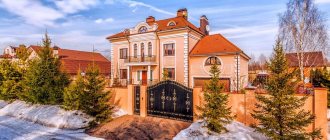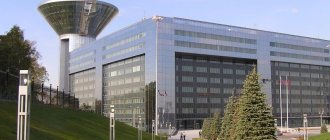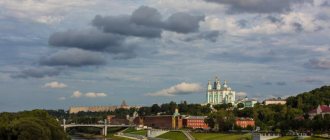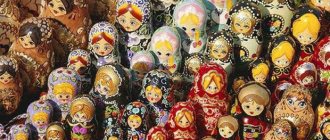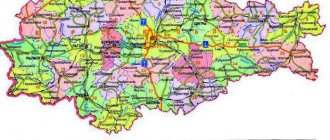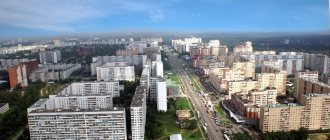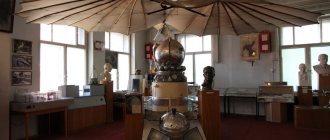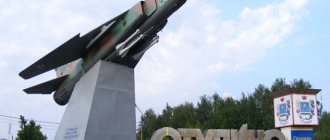Since November 2016, the 14th bus fleet entered the Yugo-Zapadny branch.
On November 26, 2016, bus No. 911 began operating, connecting the Salaryevo metro station with Vnukovo airport.
Since February 15, 2016, bus routes No. 272, 304, 420, 611k, 890 and 863 have been shortened to the Salaryevo metro station.
On July 13, 2016, bus No. 876e began running from the Salaryevo metro station to Troitsk.
Bus No. 863 (runs since October 8, 2012) - serves 14 bus fleets. The cost of travel. The bus is equipped with a turnstile.
Bus No. 890k (runs from July 11, 2016) - serves 14 bus fleets. The cost of travel. The bus is equipped with a turnstile.
Bus No. 304 has been serving 14 bus fleets since July 1, 2012. The cost of travel. The bus is equipped with a turnstile.
On a surface. Location of stops.
Nature
The region is located predominantly on the plain. In the western part it is hilly and elevated, and in the eastern part it is flat and lowland.
The climate is moderate continental, with well-defined seasons, including transitional ones. Summers are warm and winters are moderately cold. In the east of the region, winters are colder and summers are hotter. The average annual precipitation is 713 mm.
The river network belongs to the Volga River basin.
The vegetation is represented by forests and meadows. In the north, coniferous spruce forests predominate, in the south – coniferous-broad-leaved, deciduous forests.
Administrative division
This division is required to ensure management functions and is regulated by a special law of the Moscow Region. To optimize local self-government, a municipal structure is used. The territories of municipalities of the Moscow region have local urban, and not regional (unlike districts) subordination. Their typical size is small.
The region is also divided into larger administrative-territorial units - districts of the Moscow region. Each district is divided into rural and urban settlements. There are also urban districts and cities of regional subordination, as well as closed administrative-territorial entities.
The sizes of districts in the Moscow region are extremely diverse. In general, the system of administrative-territorial division in the region is quite complex and differs in this from that in other regions of the Russian Federation, for example, in the Krasnodar Territory or in the Rostov Region, which are divided into approximately equal in size districts, governed by the heads of administrations of the corresponding districts.
The total number of districts of the Moscow region is 51. The picture of the administrative-territorial division of the Moscow region is further complicated by the presence of a separate entity - the city of Moscow. Its borders are quite chaotic; There are separate island territories, also subordinate to Moscow. The Moscow urban district cuts the region almost in half, leaving only a wide northeastern bridge. Such a chaotic division can hardly be considered appropriate. Rather, it is the result of spontaneous transformations and insufficiently thought-out decisions.
Thus, the territory of Moscow and the Moscow region has a complex, confusing and not entirely rational zoning. And this differs from many other regions of the Russian Federation.
Closed education
The administrative-territorial structure of the Moscow region includes Krasnoznamensk, Vlasikha, Voskhod, Star City and Molodezhny. All of them, except the first one, are urban-type settlements (urban-type settlements). The largest of them in terms of territory is Voskhod. Its area is 15.95 square kilometers. The smallest is Star City. Its area is only 3.1 square meters. km. At the same time, Krasnoznamensk is in first place in terms of population. It is home to 40 thousand people. The population of the town of Voskhod is about 2000 people.
Protected areas of the Moscow region
Some parts of the region are under protection. Thus, in the Serpukhov region there is the Prioksko-Terrasny Biosphere Reserve. The bison and communities of the northernmost steppe formations of the European part of the country are protected there. Another important protected site is the Zavidovo National Park, part of which already belongs to the Tver region. Other protected objects are: the Botanical Garden of Medicinal Plants, a natural monument called “Lake Kiev”, and the Yablokov Arboretum.
In total, there are more than 200 specially protected natural areas in the region. To improve the quality of nature conservation, a regional Red Book has been published since 1998.
The spread of coronavirus in Russia by region today
| Region | Infected | Died | Recovered |
| Moscow | 2 535 75611 521 | 39 68482 | 2 094 53325 936 |
| Moscow region | 857 36911 956 | 13 66535 | 680 5596 369 |
| Saint Petersburg | 1 188 01019 644 | 30 45860 | 914 11911 242 |
| Nizhny Novgorod Region | 286 6445 744 | 10 69617 | 235 4201 501 |
| Sverdlovsk region | 263 0075 904 | 10 09617 | 198 3541 501 |
| Rostov region | 245 4133 571 | 10 11612 | 193 2461 202 |
| Krasnoyarsk region | 223 8335 748 | 9 58612 | 177 9281 425 |
| Dagestan | 79 359674 | 3 3673 | 68 024588 |
| Khanty-Mansiysk Autonomous Okrug - Ugra | 150 3253 471 | 2 2053 | 99 3882 430 |
| Tula region | 106 1622 475 | 4 69410 | 75 325392 |
| Voronezh region | 246 8523 288 | 7 3729 | 206 5381 435 |
| Kaluga region | 80 7321 241 | 1 3224 | 65 926210 |
| Bryansk region | 117 2371 642 | 3 3177 | 99 993783 |
| Chelyabinsk region | 202 0504 416 | 6 60213 | 157 2563 203 |
| Krasnodar region | 165 4553 021 | 10 15413 | 110 927658 |
| Saratov region | 157 5901 631 | 5 4249 | 131 579333 |
| Volgograd region | 154 1031 715 | 6 08611 | 127 778401 |
| Irkutsk region | 188 9652 713 | 7 56412 | 155 674724 |
| Novosibirsk region | 124 0063 978 | 4 7467 | 78 462424 |
| Bashkortostan | 148 3602 587 | 4 86618 | 126 7051 560 |
| Ryazan Oblast | 78 0911 295 | 2 9196 | 60 777468 |
| Ulyanovsk region | 138 0861 320 | 4 1168 | 123 229719 |
| Chuvashia | 60 9061 136 | 4 2577 | 46 832587 |
| Arhangelsk region | 164 7412 969 | 1 5712 | 123 575903 |
| Kursk region | 93 263845 | 2 2153 | 83 377228 |
| Kabardino-Balkaria | 48 654418 | 1 6114 | 42 783294 |
| Murmansk region | 108 3341 367 | 3 0027 | 90 9221 304 |
| Yaroslavl region | 102 2491 319 | 2 16711 | 84 825415 |
| Tambov Region | 76 1441 184 | 1 9946 | 62 376349 |
| Samara Region | 254 0233 582 | 6 81214 | 210 9931 728 |
| Stavropol region | 157 0381 750 | 6 57114 | 133 2371 246 |
| Penza region | 119 4192 150 | 4 96210 | 97 468156 |
| Smolensk region | 98 013850 | 2 6454 | 84 412273 |
| Tatarstan | 58 7641 514 | 1 6385 | 41 654630 |
| Oryol Region | 85 580961 | 1 6608 | 71 390287 |
| Yamalo-Nenets Autonomous Okrug | 90 6751 451 | 9951 | 66 608519 |
| Ivanovo region | 76 282675 | 2 7464 | 64 095266 |
| Leningrad region | 134 4582 766 | 3 2105 | 106 545502 |
| Vladimir region | 102 8931 653 | 3 1397 | 84 669351 |
| Belgorod region | 95 3991 198 | 1 9612 | 83 069491 |
| North Ossetia | 35 544208 | 1 1365 | 31 527102 |
| Yakutia | 129 9572 950 | 1 9043 | 103 1984 830 |
| Primorsky Krai | 121 6791 517 | 1 7486 | 100 348463 |
| Khabarovsk region | 143 7821 356 | 1 3672 | 128 873399 |
| Lipetsk region | 102 6911 643 | 3 1128 | 85 174749 |
| Tyva | 39 465572 | 3360 | 33 953322 |
| Orenburg region | 135 5532 651 | 3 6182 | 107 1251 197 |
| Astrakhan region | 95 502855 | 2 7187 | 82 793306 |
| Perm region | 224 2605 005 | 7 91620 | 162 529733 |
| Tver region | 121 1161 581 | 2 4691 | 92 63053 |
| Mordovia | 48 120506 | 1 1893 | 40 410205 |
| Omsk region | 160 6642 445 | 3 66415 | 135 9521 508 |
| Kirov region | 99 8571 684 | 8422 | 82 483628 |
| Ingushetia | 34 407370 | 5171 | 29 984211 |
| Komi Republic | 118 3531 814 | 2 801 | 98 031682 |
| Karachay-Cherkessia | 37 777398 | 9461 | 32 134127 |
| Mari El | 36 873516 | 9895 | 29 536129 |
| Tyumen region | 123 1272 802 | 3 7834 | 88 503231 |
| Buryatia | 101 0181 601 | 2 6708 | 81 678901 |
| Transbaikal region | 110 2851 229 | 2 0694 | 97 9811 312 |
| Novgorod region | 77 301855 | 8641 | 69 400332 |
| Kaliningrad region | 107 0902 003 | 1 5008 | 83 375105 |
| Pskov region | 78 864537 | 1 4810 | 72 756193 |
| Kamchatka Krai | 28 737342 | 5610 | 20 82484 |
| Tomsk region | 75 315981 | 7182 | 64 978131 |
| Chechnya | 39 606511 | 1 0424 | 31 06360 |
| Khakassia | 67 9081 003 | 2 1525 | 56 2411 194 |
| Adygea | 33 903493 | 8402 | 27 811276 |
| Vologda Region | 120 7621 916 | 3 2444 | 103 173985 |
| Kalmykia | 41 532418 | 7982 | 34 582237 |
| Kostroma region | 58 806969 | 1 1911 | 49 558142 |
| Amur region | 63 511983 | 6954 | 58 77674 |
| Kemerovo region | 106 8771 999 | 1 9787 | 88 747381 |
| Udmurtia | 102 5052 044 | 3 3675 | 84 8771 121 |
| Karelia | 106 3131 182 | 1 3526 | 100 487684 |
| Republic of Crimea | 140 101915 | 4 7806 | 128 126327 |
| Magadan Region | 15 845161 | 3623 | 15 038300 |
| Kurgan region | 62 1231 220 | 1 0652 | 52 688109 |
| Sakhalin region | 49 150592 | 6823 | 45 313209 |
| Altai region | 159 1874 098 | 7 54319 | 115 4051 485 |
| Altai Republic | 28 135204 | 5721 | 24 36344 |
| Jewish Autonomous Region | 12 62178 | 4652 | 11 27317 |
| Sevastopol | 61 989397 | 2 0015 | 52 452102 |
| Chukotka Autonomous Okrug | 3 50258 | 400 | 2 9876 |
| Nenets Autonomous Okrug | 4 81698 | 920 | 3 600104 |
Municipal districts of the Moscow region
In total, there are 36 municipal districts in the Moscow region:
— Volokolamsk with its center in the city of Volokolamsk (index 143600).
- Voskresensky with its center in the city of Voskresensk (index 140200).
— Dmitrovsky with its center in the city of Dmitrov (index 141800).
— Zaraisky with its center in the city of Zaraysk (index 140600).
— Yegoryevsky with its center in the city of Yegoryevsk (index 140300).
— Istra with its center in the city of Istra (index 143500).
— Klinsky with its center in the city of Klin (index 141600).
— Kashirsky with its center in the city of Kashira (index 142903).
- Krasnogorsk with its center in the city of Krasnogorsk (index 143404).
- Kolomensky with its center in the city of Kolomna (index 140407).
- Leninsky with its center in the city of Vidnoye, Leninsky district (index 142700).
— Lukhovitsky with its center in the city of Lukhovitsy (index 140501).
— Lotoshinsky with its center in the city of Lotoshino, Lotoshinsky district (index 143800).
— Lyubertsy with its center in the city of Lyubertsy (index 140000).
— Mytishchi with its center in the city of Mytishchi (index 141008).
— Mozhaisk with its center in the city of Mozhaisk (index 143200).
— Naro-Fominsk with its center in the city of Naro-Fominsk (index 143300).
— Ozersky with its center in the city of Ozyory (index 140560).
— Odintsovo with its center in the city of Odintsovo (index 143000).
— Noginsky with its center in the city of Noginsk (index 142400).
— Podolsky with its center in the city of Podolsk (index 142100).
— Orekhovo-Zuevo with its center in the city of Orekhovo-Zuevo (index 142600).
— Pavlovsky Posad with its center in the city of Pavlovsky Posad (index 142500).
— Pushkinsky with its center in the city of Pushkino (index 141207).
— Ramenskoye with its center in the city of Ramenskoye (index 140100).
— Sergiev Posad with its center in the city of Sergiev Posad (index 141300).
- Ruzsky with its center in the city of Ruza (index 143100).
— Solnechnogorsk with its center in the city of Solnechnogorsk (index 141500).
— Serpukhovsky with its center in the city of Serpukhov (index 142203).
— Serebryano-Prudsky with its center in the city of Serebryanye Prudy, Serebryano-Prudsky district (index 142970).
- Stupinsky with its center in the city of Stupino (index 142800).
- Taldomsky with its center in the city of Taldom (index 141900).
— Shatura with its center in the city of Shatura (index 140700).
- Chekhovsky with its center in the city of Chekhov (index 142300).
— Shakhovsky with its center in the city of Shakhovskaya, Shakhovsky district (index 143700).
— Shchelkovsky with its center in the city of Shchelkovo (index 141100).
Tourist sites
The Moscow region is rich in attractions. Perhaps you can find much more interesting tourist sites there than in the capital. Here you can not only have a good rest, but also learn a lot of new things. One of the main pearls of the Moscow region is the village of Arkhangelskoye. In the summer, a whole string of residents and guests of the capital flocks here. And not in vain, because in Arkhangelskoye there is a palace and park ensemble, laid out in the likeness of the one in Peterhof. Another interesting tourist attraction in the Moscow region is Pancake Mountain. From the observation deck there is an excellent view of the Trinity-Sergius Lavra.
You can’t help but visit Bolshiye Vyazemy, the poetic birthplace of Pushkin. Many interesting monuments of Russian culture are collected here. One of the most visited tourist sites in Dmitrov is the monastery. This is a place of pilgrimage for many Orthodox Christians. On the territory of the monastery there is the Cathedral of Boris and Gleb, built in the 16th century. Another attraction of the Moscow region is the Gremyachiy Klyuch waterfall. As the ancient legend says, he appeared through the prayer of St. Sergius of Radonezh. There are many more tourist sites located in the Moscow region. By visiting them, you can better understand Russian history and culture. And of course, just relax and enjoy the beauty of the world around you!
Improvement of the territory of the Moscow region
Territory improvement work is focused primarily on improving the condition of the courtyards of multi-storey buildings. For this purpose there is a special law “On improvement in the Moscow region”. When implementing it, methodological recommendations are used for organizing comprehensive landscaping of courtyard areas. This is the responsibility of the administration of the corresponding urban settlement.
The courtyard area is understood as land directly adjacent to apartment buildings and in common use. It may include a playground, parking, waste storage area, green space, lights, posters and other public facilities.
Comprehensive landscaping of the territory means bringing all the components of the territory described above to a standard state.
Activities to provide all these attributes and maintain them in proper condition are carried out annually. The greatest complaints are caused by the insufficient level of lighting in the areas and the dilapidation of children's playgrounds. There are also considerable problems with the condition of the road surface of internal and external roads.
Active work on comprehensive improvement was carried out in 2016. They included asphalting roads and paths, overhauling playgrounds, installing additional play elements, repairing fences, and installing information stands.
Main socio-economic indicators
We looked at how large the area of the Moscow region is in hectares. It makes up 0.3% of the territory of the Russian Federation. Now we can move on to other socio-economic indicators. The average annual number of employed people in the Moscow region is 3.041 million people. They receive an average of 34,947 rubles per month. Moreover, per capita expenses are about 24 thousand. The average nominal salary per month in the Moscow region according to 2015 data is 38,598 rubles.
In terms of gross regional product, the subject is in second place in the country. In 2014 it amounted to 2.7 trillion rubles. This is about 400 thousand per capita. The service sector provides more than half of the gross regional product. The structure of GRP of the Moscow region is as follows:
- Energy – 4.9%.
- Manufacturing industry – 25.5%.
- Service sector – 52.9%.
The region has significant investment potential. It is in third place in terms of the number of organizations that have foreign capital. An important feature of the geographical location of the region is its proximity to the capital of Russia. The proximity of the latter contributes to the development of the region and makes it attractive for migration. Sometimes he even takes over the capital's labor resources. There is a budget deficit in the Moscow region. The main source of income is taxes. The waste includes social payments, in particular for education and health care. In terms of industrial volume, the region is in second place, right after the capital. The leading industries are food, mechanical engineering, chemical and metallurgy.
Ecological improvement
As part of the general improvement of the territory of the Moscow region, much attention should be paid to environmental measures. For example, such as clearing areas of garbage, cleaning water bodies, improving the condition of the road surface, landscaping residential complexes and public areas, repairing playgrounds, repairing dilapidated and dilapidated housing, and so on.
The obligatory nature of such events is dictated by considerations of quality of life and safety of the population. Thus, according to research by European scientists, the accumulation of plastic household waste in inappropriate places (landfills, ponds, etc.) and the abrasion of car tires by road surfaces leads to increasing pollution of all environments with microscopic particles and fibers of artificial polymers. And if we continue to turn a blind eye to this, then in the future there will be such a number of them that the health of a huge number of the planet’s inhabitants will be jeopardized.
Prospects
According to experts, residential real estate in the city of Moskovsky will become even more in demand: the reason for this is the proximity to the capital, the massive commissioning of new housing and the fact that prices on the market for new buildings in Moskovsky are not yet so high.
What can be concluded? The city of Moscow has a certain investment attractiveness and favorable prospects, and is an interesting object for those who want to invest available funds in real estate in order to subsequently make a profit from resale or rental.
Apartments in new buildings in Moskovsky are more affordable than their analogues, for example, in Podolsk, because the main segment of housing being built is economy and economy+: these are standard panel houses of well-proven series (for example, P-44T, which flooded Moscow at the very end of 1990- x - early 2000s) without security, parking and with not very high ceilings, partial possibility of redevelopment, but allowing the owner to buy a larger number of square meters for himself and his future family compared to, say, a monolithic house of an individual project.
Did you find this article helpful? Please share it on social networks: Don't forget to bookmark the Nedvio website. We talk about construction, renovation, and country real estate in an interesting, useful and understandable way.
